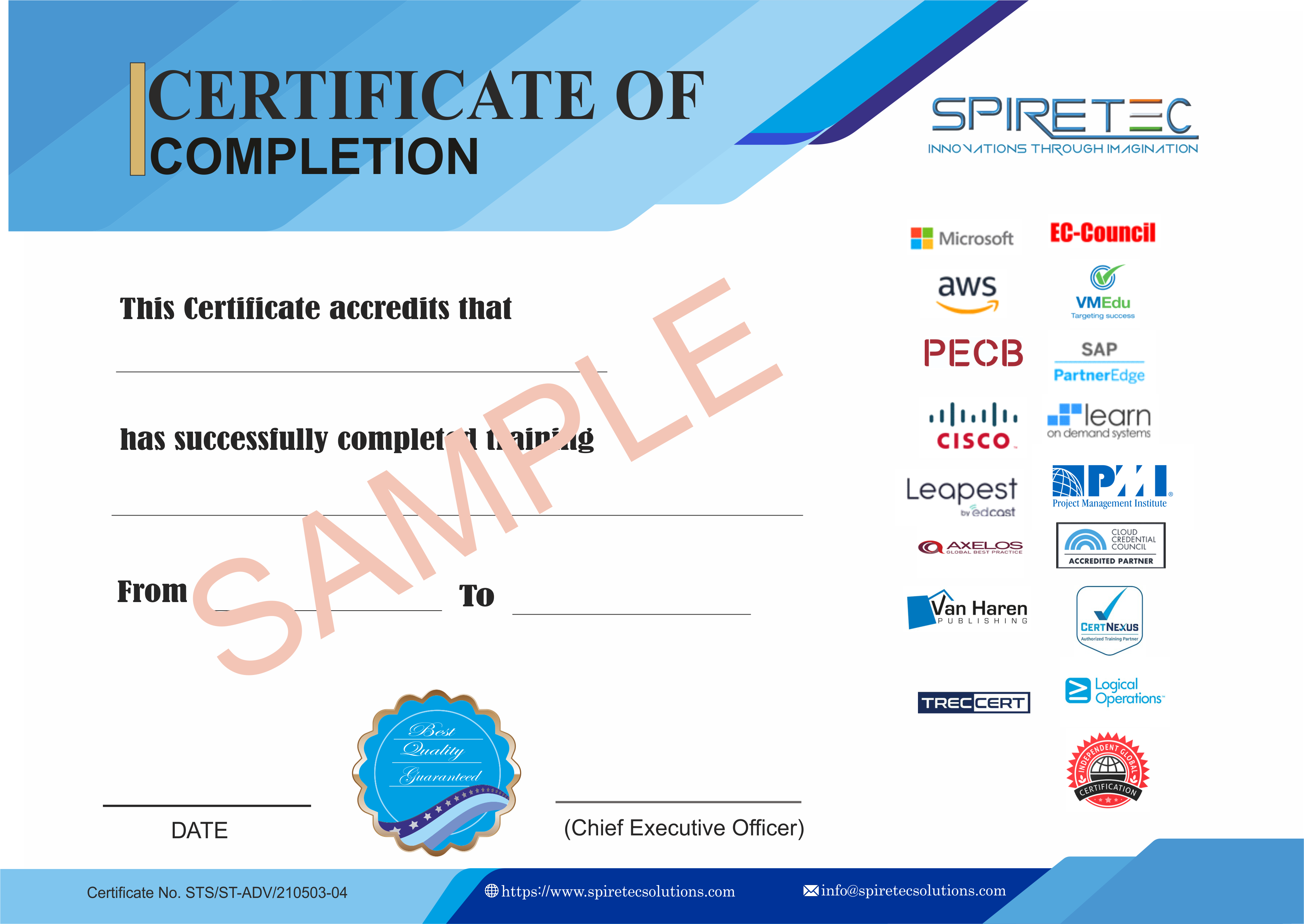The SSCP course provides foundational training for IT professionals aiming to demonstrate their expertise in security. It equips learners with the skills to implement, monitor, and administer IT infrastructure according to cybersecurity policies and procedures, ensuring data confidentiality, integrity, and availability. The course covers various aspects of security operations, including access controls, risk management, incident response, cryptography, network security, and systems and application security. Completing the SSCP certification demonstrates technical ability in addressing operational security challenges and adhering to best practices, making it an excellent starting point for a career in cybersecurity.
Course Prerequisites
To undertake the SSCP course, the following prerequisites are recommended:
-
Basic Understanding of Security Concepts: Familiarity with core principles like confidentiality, integrity, and availability.
-
Fundamental IT Knowledge: Foundational understanding of computer systems, networking concepts, and the Internet.
-
Working Knowledge of Computer Systems: Experience with managing operating systems, user environments, and software applications.
-
Basic Networking Skills: Understanding of networking concepts, including TCP/IP protocols, network architecture, and secure components.
-
Familiarity with Access Control Concepts: Knowledge of authentication, authorization, and security mechanisms.
-
Awareness of Risk Management: Recognition of risk assessment importance and basic risk management concepts.
-
Interest in Security Practices: Enthusiasm for learning about security policies, standards, and secure design principles.
-
Ethical Mindset: Commitment to ethical behavior in cybersecurity.
-
Communication Skills: Basic skills to document and explain security controls, incidents, and assessments.
Target Audience
The SSCP course is aimed at:
-
IT Security Analysts
-
Network Security Engineers
-
Systems Administrators
-
Security Administrators
-
Security Consultants/Specialists
-
IT Auditors
-
Information Security Officers
-
IT/Security Practitioners
-
Systems Analysts
-
Database Administrators
-
Government or military IT professionals
-
Incident Response Handlers
-
Risk/Threat/Vulnerability Analysts
-
Security Operations Center (SOC) staff
-
Compliance Personnel
-
Professionals transitioning into cybersecurity
-
Technical Support Engineers specializing in security
-
Individuals preparing for the ISC² SSCP certification exam
Learning Objectives
The SSCP course aims to equip learners with essential cybersecurity skills, including:
-
Authentication and Access Control: Implement and manage secure access and identity management processes.
-
Trust Architectures and Access Control: Develop and support internetwork trust architectures and access control mechanisms.
-
Ethical Codes in Security: Apply ethical codes and comply with industry standards in security operations.
-
Security Controls and Asset Management: Document, implement, and maintain security controls, and manage assets and changes.
-
Risk Assessment and Continuous Monitoring: Conduct risk assessments, operate monitoring systems, and analyze security data to mitigate threats.
-
Incident Response and Forensics: Support incident response, forensic investigations, business continuity, and disaster recovery.
-
Cryptography and Secure Protocols: Understand and implement cryptography, secure protocols, and Public Key Infrastructure (PKI).
-
Network Security: Manage network security, deploy countermeasures, and secure communication technologies, including wireless networks.
-
Endpoint and Cloud Security: Identify and mitigate risks associated with malicious code, secure endpoints, cloud environments, and virtual systems.
Course Outline:
Domain 1: Access Controls
1. Implement and Maintain Authentication Methods
2. Support Internetwork Trust Architectures
3. Participate in the Identity Management Lifecycle
4. Implement Access Controls
-
Mandatory
-
Non-discretionary
-
Discretionary
-
Role-based
-
Attribute-based
-
Subject-based
-
Object-based
Domain 2: Security Operations and Administration
1. Comply with Codes of Ethics
2. Understand Security Concepts
-
Confidentiality
-
Integrity
-
Availability
-
Accountability
-
Privacy
-
Non-repudiation
-
Least privilege
-
Separation of duties
3. Document, Implement, and Maintain Functional Security Controls
-
Deterrent controls
-
Preventative controls
-
Detective controls
-
Corrective controls
-
Compensating controls
4. Participate in Asset Management
-
Lifecycle (hardware, software, and data)
-
Hardware inventory
-
Software inventory and licensing
-
Data storage
5. Implement Security Controls and Assess Compliance
-
Technical controls (e.g., session timeout, password aging)
-
Physical controls (e.g., mantrap, cameras, locks)
-
Administrative controls (e.g., security policies, procedures, baselines)
-
Periodic audit and review
6. Participate in Change Management
-
Execute change management process
-
Identify security impact
-
Testing/implementing patches, fixes, and updates (e.g., OS, apps, SDLC)
7. Participate in Security Awareness and Training
8. Participate in Physical Security Operations
Domain 3: Risk Identification, Monitoring, and Analysis
1. Understand the Risk Management Process
-
Risk visibility and reporting (e.g., risk register, threat intelligence, CVSS)
-
Risk management concepts (e.g., impact assessments, threat modeling, BIA)
-
Risk management frameworks (e.g., ISO, NIST)
-
Risk treatment (e.g., accept, transfer, mitigate, avoid, recast)
2. Perform Security Assessment Activities
-
Participate in security testing
-
Interpretation and reporting of scanning and testing results
-
Remediation validation
-
Audit finding remediation
3. Operate and Maintain Monitoring Systems
-
Events of interest (e.g., anomalies, intrusions, unauthorized changes)
-
Logging
-
Source systems
-
Legal and regulatory concerns (e.g., jurisdiction, privacy limitations)
4. Analyze Monitoring Results
-
Security baselines and anomalies
-
Visualizations, metrics, and trends (e.g., dashboards)
-
Event data analysis
-
Document and communicate findings (e.g., escalation)
Domain 4: Incident Response and Recovery
1. Support Incident Lifecycle
-
Preparation
-
Detection, analysis, and escalation
-
Containment
-
Eradication
-
Recovery
-
Lessons learned/new countermeasures
2. Understand and Support Forensic Investigations
-
Legal and ethical principles
-
Evidence handling (e.g., triage, chain of custody, preservation)
3. Understand and Support BCP and DRP Activities
-
Emergency response plans (e.g., contingency plans)
-
Interim/alternate processing strategies
-
Restoration planning
-
Backup and redundancy implementation
-
Testing and drills
Domain 5: Cryptography
1. Understand Fundamental Concepts of Cryptography
-
Hashing, salting
-
Symmetric/Asymmetric encryption, ECC
-
Non-repudiation (e.g., digital signatures, HMAC)
-
Encryption algorithms (e.g., AES, RSA)
-
Key strength (256–2048-bit)
-
Cryptographic attacks and countermeasures
2. Understand Reasons and Requirements for Cryptography
-
Confidentiality
-
Integrity and authenticity
-
Data sensitivity (e.g., PII, PHI, IP)
-
Regulatory
3. Understand and Support Secure Protocols
-
Services/protocols (e.g., IPSec, TLS, S/MIME, DKIM)
-
Use cases
-
Limitations and vulnerabilities
4. Understand Public Key Infrastructure (PKI) Systems
-
Key management (e.g., rotation, creation, escrow)
-
Web of Trust (e.g., PGP, GPG)
Domain 6: Network and Communications Security
1. Understand and Apply Networking Concepts
-
OSI and TCP/IP models
-
Network topographies (e.g., ring, star, mesh)
-
Relationships (e.g., client-server, P2P)
-
Transmission media (e.g., fiber, wireless)
-
Common ports and protocols
2. Understand Network Attacks and Countermeasures
3. Manage Network Access Controls
-
NAC and monitoring (e.g., quarantine)
-
NAC standards/protocols (e.g., IEEE 802.1X, Radius, TACACS)
-
Remote access (e.g., SSL VPN, IPSec, telework)
4. Manage Network Security
-
Placement of devices (inline/passive)
-
Segmentation (e.g., VLANs, ACLs)
-
Secure device management
5. Operate and Configure Network-Based Security Devices
-
Firewalls, proxies, IDS/IPS
-
Routers and switches
-
Traffic-shaping devices (e.g., WAN optimization)
6. Operate and Configure Wireless Technologies
-
e.g., Bluetooth, NFC, WiFi
-
Wireless security and devices (e.g., WIPS, WIDS)
Domain 7: Systems and Application Security
1. Identify and Analyze Malicious Code and Activity
-
Malware types (e.g., ransomware, trojans, rootkits)
-
Countermeasures (e.g., anti-malware, code signing, sandboxing)
-
Malicious activities (e.g., insider threat, botnets)
-
Activity countermeasures (e.g., awareness, patching, isolation)
2. Implement and Operate Endpoint Device Security
3. Operate and Configure Cloud Security
-
Deployment models (public, private, hybrid, community)
-
Service models (IaaS, PaaS, SaaS)
-
Virtualization (e.g., hypervisor)
-
Legal concerns (privacy, data ownership, eDiscovery)
-
Storage/transmission (archiving, recovery, resilience)
-
Third-party/outsourcing (SLA, data destruction, auditing)
-
Shared responsibility model
4. Operate and Secure Virtual Environments











 Live Online Training (Duration : 40 Hours)
Live Online Training (Duration : 40 Hours)
